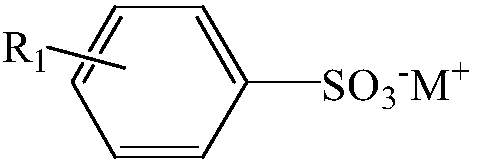Use of polymer as protease stabilizing agent in detergent and detergent composition
A protease stabilizer, detergent technology, applied in detergent compositions, surface active detergent compositions, organic detergent compositions, etc., can solve the problems of insufficient protease stability, inability to improve protease decontamination performance, etc. Anti-fouling redeposition performance, improving the stability of protease, the effect of improving the retention rate of enzyme activity
- Summary
- Abstract
- Description
- Claims
- Application Information
AI Technical Summary
Problems solved by technology
Method used
Image
Examples
preparation example Construction
[0131] Process for the preparation of liquid detergent compositions
[0132] 1) Add part of deionized water to the configuration tank;
[0133] 2) Start stirring, heat up to 50 to 60°C, convert fatty acid into fatty acid salt under alkaline conditions, and stir until completely dissolved;
[0134] 3) Add surfactant and stir until completely dissolved;
[0135] 4) Stop heating, add the remaining amount of deionized water to the configuration tank, and accelerate the cooling;
[0136] 5) When the temperature drops below 40°C, add polymers, enzyme preparations, flavors, preservatives and other components, and stir until they are completely dissolved;
[0137] 6) Add viscosity modifier, stir until completely dissolved, adjust pH value and viscosity, discharge after passing the test.
Embodiment 1
[0139] The formulations of the liquid detergent compositions of Example 1 and Comparative Examples 1-3 are shown in Table 1 below, wherein the weight average molecular weight of the polyethyleneimine main chain in the ethoxylated polyethyleneimine is 300, and the ethoxylated polyethyleneimine The average degree of ethoxylation of polyethyleneimine is 2.
[0140] The formula composition of the liquid detergent composition of table 1 embodiment 1 and comparative example 1-3
[0141]
[0142]
[0143] Stain removal performance test
[0144] The decontamination performance test is carried out according to GB / T 13174-2008. Using JB-01 (carbon black), JB-02 (protein) and JB-03 (sebum) three national standard stained cloths, use WSD-3U fluorescent whiteness meter to measure the whiteness W of the three stained cloths before washing 1 . Prepare washing water with a hardness of 250ppm according to GB / T13174-2008, in which the ratio of calcium and magnesium ions is 3:2.
[014...
Embodiment 2
[0167] The formulations of the liquid detergent compositions of Example 2 and Comparative Examples 4-6 are shown in Table 3 below, wherein the weight average molecular weight of the polyethyleneimine main chain in the ethoxylated polyethyleneimine is 400, and the ethoxylated polyethyleneimine The average degree of ethoxylation of polyethyleneimine is 20.
[0168] The formula composition of the liquid detergent composition of table 3 embodiment 2 and comparative example 4-6
[0169]
[0170] The decontamination performance test method of the liquid detergent composition prepared by comparative examples 4-6 and embodiment 2 is the same as the decontamination performance test method of the above-mentioned embodiment 1 and comparative examples 1-3, and the decontamination performance test results are as shown in table 4 show, among them,
[0171] P3 represents the relative detergency of the albumen stained cloth of the liquid detergent composition (embodiment 2) containing eth...
PUM
 Login to View More
Login to View More Abstract
Description
Claims
Application Information
 Login to View More
Login to View More - R&D
- Intellectual Property
- Life Sciences
- Materials
- Tech Scout
- Unparalleled Data Quality
- Higher Quality Content
- 60% Fewer Hallucinations
Browse by: Latest US Patents, China's latest patents, Technical Efficacy Thesaurus, Application Domain, Technology Topic, Popular Technical Reports.
© 2025 PatSnap. All rights reserved.Legal|Privacy policy|Modern Slavery Act Transparency Statement|Sitemap|About US| Contact US: help@patsnap.com



